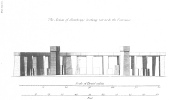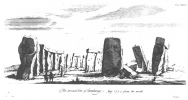
Sacred Texts Legends & Sagas England Index Previous Next


Stonehenge, A Temple Restor'd to the British Druids, by William Stukeley, [1740], at sacred-texts.com
Of the number of the stones. Of the altar-stone. Of what has been found in digging, about the temple. A plate of tin of the Druids writing. A plate of gold, supposed to be of the Druids writing.
THUS have we finished the work, or principal part of this celebrated wonder; properly the temple or sacred structure, as it may be called. Tho’ its loftiest crest be compos’d but of one stone, laid upon another. "A work, as Mr. Webb says justly, p. 65. built with much art, order and proportion." And it must be own’d, that they who had a notion, that it was an unworthy thing, to pretend to confine the deity in room and space, could not easily invent a grander design than this, for sacred purposes: nor execute it in a more magnificent manner. Here space indeed is mark’d out and defin’d: but with utmost freedom and openness. Here is a kebla intimating, but not bounding the presence of the Deity. Here the variety and harmony of four differing circles presents itself continually new, every step we take, with opening and closing light and shade. Which way so ever we look, art and nature make a composition of their highest gusto, create a pleasing astonishment, very apposite to sacred places.
The great oval consists of 10 uprights, the inner with the altar, of 20, the great circle of 30, the inner of 40. to, 20, 30, 40 together, make 100 upright stones. 5 imposts of the great oval, 30 of the great circle, the 2 stones standing upon the bank of the area, the stone lying within the entrance of the area, and that standing without. There seems to have been another stone lying upon the ground, by the vallum of the court, directly opposite to the entrance of the avenue. All added together, make just 140 stones, the number of which Stonehenge, a whole temple, is compos’d. Behold the solution of the mighty problem, the magical spell is broke, which has so long perplex’d the vulgar! they think ’tis an ominous thing to count the true number of the stones, and whoever does so, shall certainly die after it. Thus the Druids contented themselves to live in huts and caves: whilst they employ’d many thousands of men, a whole county, to labour at these publick structures, dedicated to the Deity.
Our altar here is laid toward the upper end of the adytum, at present flat on the ground, and squeez’d (as it were) into it, by the weight of the ruins upon it. ’Tis a kind of blue coarse marble, such as comes from Derbyshire, and laid upon tombs in our churches and church-yards. Thus Virgil describes an ancient altar, after the Etruscan fashion, and which probably had remain’d from patriarchal times.
Servius upon the IIId Georg. says, in the middle of a temple was the place of the Deity: the rest was only ornamental. This altar is plac’d a little above the focus of the upper end of the ellipsis. Mr. Webb says, p. 56. the altar is 4 foot broad, 16 in length. 4 foot is 2 cubits 2 palms, which at four times measures 16 foot. I believe its breadth is 2 cubits 3 palms, i.e. 1 and a half: and that its first intended length was 10 cubits, equal to the breadth of the trilithon before which it lies. But ’tis very difficult to come at its true length. ’Tis 20 inches thick, a just cubit, and has been squar’d. It lies between the

Click to enlarge
Plate 16. The Section of Stonehenge looking towards the Entrance.
two centers, that of the compasses and that of the string: leaving a convenient space quite round it, no doubt, as much as was necessary for their ministration.
Mr. Webb says, the heads of oxen, and deer, and other beasts have been found upon digging in and about Stonehenge, as divers then living could testify, undoubted reliques of sacrifices, together with much charcoal, meaning wood-ashes. Mr. Camden says, mens bones have been found hereabouts. He means in the barrows adjacent, and I saw such thrown out by the rabbets very near the temple. But eternally to be lamented is the loss of that tablet of tin, which was found at this place, in the time of King Henry VIII. (the Æra of restitution of learning and of pure religion) inscrib’d with many letters, but in so strange a character, that neither Sir Thomas Elliot a learned antiquary, nor Mr. Lilly master of St. Paul's school, could make any thing out of it. Mr. Sammes may be in the right, who judges it to have been Punic; I imagine if we call it Irish, we shall not err much. No doubt but it was a memorial of the founders, wrote by the Druids: and had it been preserv’d till now, would have been an invaluable curiosity. To make the reader some amends for such a loss, I have given a specimen of supposed Druid writing, out of Lambecius's account of the Emperor's library at Vienna. ’Tis wrote on a wry thin plate of gold, with a sharp-pointed instrument. It was in an urn found at Vienna, roll’d up in several cases of other metal, together with funeral exuviæ. It was thought by the curious, one of those epistles, which the Celtic people were wont to send to their friends in the other world. So certain a hope of a future pate had the Druids infus’d into them. The reader may divert himself with endeavouring to explain it. The writing upon plates of gold or tin is exceeding ancient, as we see in Job xix. 24.
Plutarch in his pamphlet de dæmonio Socratis tells a similar story. “About the time of Agesilaus, they found a brazen tablet in the sepulchre of Ahemena at Thebes, wrote in characters unknown, but seem’d to be Egyptian. Chonuphis, the most learned of the Egyptian prophets then, being consulted upon it, confirm’d it, and said it was wrote about the time of Hercules and Proteas king in Egypt. Tzetzes, chil. 2. hist. 44. mentions Proteus a king in lower Egypt by the sea side, pretends he was son of Neptune and Phœnicia, throwing him up thereby to very ancient times, those of the first famous navigators, our Hercules and the Phœnicians. He is said to have lived in the island afterward call’d Pharos, from the watch-tower there erected. Here Homer sings, that Proteus diverts himself with his phocæ or sea-calves, most undoubtedly
his ships. But at that time of day, every thing new and strange was told by the Greeks in a mythologic way.
In the year 1635, as they were plowing by the barrows about Normanton ditch, they found a large quantity of excellent pewter, as much as they sold at a low price for 5l. says Mr. Aubry in his manuscript collections, relating to antiquities of this sort. There are several of these ditches, being very small in breadth, which run across the downs. I take them for boundaries of hundreds, TAB. XXXI. parishes, &c. Such as the reader may observe in my Plate XXXI. of the barrows in Lake-field. I suspect this too was a tablet with an inscription on it, but falling into the hands of the countrymen, they could no more discern the writing, than interpret it. No doubt but this was some of the old British stanum, which the Tyrian Hercules, sirnam’d Melcarthus, first brought ex Cassiteride insula, or Britain. Which Hercules liv’d in Abraham's time, or soon after.
Mr. Webb tells us, the Duke of Buckingham dug about Stonehenge: I fear much to the prejudice of the work. He himself did the like, and found what he imagin’d was the cover of a thuribulum. He would have done well to have given us a drawing of it. But whatever it was, vases of incense, oil, slower, salt, wine and holy water, were used by all nations in their religious ceremonies.
Mr. Thomas Hayward, late owner of Stonehenge, dug about it, as he acquainted Lord Winchelsea and myself. He found heads of oxen and other beasts bones, and nothing else. In 1724. when I was there, Richard Hayns an old man of Ambresbury, whom I employed to dig for me in the barrows, found some little worn-out Roman coins at Stonehenge, among the earth rooted up by the rabbets. He sold one of them for half a crown, to Mr. Merril of Golden Square, who came thither whilst I was at the place. The year before, Hayns was one of the workmen employ’d by Lord Carlton to dig clay on Harradon hill, east of Ambresbury, where they found many Roman coins, which I saw. I suspect he pretended to find those at Stonehenge, only for sake of the reward. My friend the late Dr. Harwood of Doctors-Commons told me, he was once at Stonehenge with such sort of Roman coins in his pockets, and that one of his companions would have persuaded him, to throw some of them into the rabbit-holes: but the Doctor was more ingenuous. Nevertheless were never so many such coins found in Stonehenge, they would prove nothing more, than that the work was in being, when the Romans were here; and which we are assured of already. I have a brass coin given me by John Collins Esq; collector of the excise at Stamford. The heads of Julius and Augustus averse: the reverse a crocodile, palm-branch and garland. COL. NEM. the colony of Nemausus in France. It was found upon Salisbury plain; and might be lost there before the Roman conquest of Britain under Claudius, by people of France coming hither; or in after-ages: no matter which.
July 5 1723. By Lord Pembroke's direction, I dug on the inside of the altar about the middle: 4 foot along the edge of the stone, 6 foot forward toward the middle of the adytum. At a foot deep, we came to the solid chalk mix’d with flints, which had never been stir’d. The altar was exactly a cubit thick, 20 inches and 4/5; but broken in two or three pieces by the ponderous masses of the impost, and one upright stone of that trilithon which stood at the upper end of the adytum, being fallen upon it. Hence appears the commodiousness of the foundation for this huge work. They dug holes in the solid chalk, which would of itself keep up the stones, as firm as is a wall was built round them. And no doubt but they ramm’d up the interstices with flints. But I had too much regard to the work, to dig any where near the stones. I took up an oxe's tooth, above ground, without the adytum on the right hand of the lowermost trilithon, northward. And this is all the account, of what has been found by digging at Stonehenge, which I can give.

Click to enlarge
Plate 17. An inward View of Stonehenge. Aug. 1722 from the north.